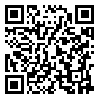Volume 7, Issue 6 (2-2012)
J Health Syst Res 2012, 7(6): 0-0 |
Back to browse issues page
Download citation:
BibTeX | RIS | EndNote | Medlars | ProCite | Reference Manager | RefWorks
Send citation to:



BibTeX | RIS | EndNote | Medlars | ProCite | Reference Manager | RefWorks
Send citation to:
حبيباله دهقان, احساناله حبيبي, روحاله پروري, سيامک پورعبديان, محمدرضا مراثي. بررسی تأثیر جنس لباس کار بر شاخص استرین فیزیولوژیکی (PSI) مردان در شرایط آب و هوایی گرم در اتاقک شرایط جوی. J Health Syst Res 2012; 7 (6)
URL: http://hsr.mui.ac.ir/article-1-325-en.html
URL: http://hsr.mui.ac.ir/article-1-325-en.html
1- Lecture, Department of Occupational Health Engineering, School of Health, Isfahan University of Medical Sciences, Isfahan, Iran
2- Associate Professor, Department of Occupational Health Engineering, School of Health, Isfahan University of Medical Sciences, Isfahan, Iran
3- MSc Student, Student Research Committee, Department of Occupational Health Engineering, School of Health, Isfahan University of Medical Sciences, Isfahan, Iran
4- Assisstant Professor, Department of Occupational Health Engineering, School of Health, Isfahan University of Medical Sciences, Isfahan, Iran
2- Associate Professor, Department of Occupational Health Engineering, School of Health, Isfahan University of Medical Sciences, Isfahan, Iran
3- MSc Student, Student Research Committee, Department of Occupational Health Engineering, School of Health, Isfahan University of Medical Sciences, Isfahan, Iran
4- Assisstant Professor, Department of Occupational Health Engineering, School of Health, Isfahan University of Medical Sciences, Isfahan, Iran
Abstract: (1392 Views)
Background: Work clothing can limit heat exchange between humans and the environment and cause thermal strain and heat-related disorders in workers. It can thus reduce both efficiency and productivity. The purpose of this study was to examine the effects of work clothing material on physiological strain index (PSI) in climatic chamber. Methods: An interventional study was conducted on 18 male students. Heart rate and core temperature of individuals were measured (by Polar RS100 and Questemp II) and recorded in 16 tests that were the combination of 4 normal work clothing (1-4), two activity levels (low and moderate), two kinds of conditions (hot and dry and hot and wet). Data analysis was performed using repeated measures in SPSS. Findings: Our findings showed that in hot and wet conditions, the lowest average value of PSI in low and moderate activities were related to clothing types 4 and 2, respectively. In the hot and dry conditions, the highest average value of PSI in both activity levels were related to clothing type 2. Average value of PSI of clothing types had a significant difference in hot and wet conditions during moderate activity (P = 0.044). Conclusion: Our results indicated that in order to reduce heat strain in hot and wet conditions, it is suggested to use 100% cotton clothing for light activity and 30.2% cotton-69.8% polyester clothing for moderate activity. In hot and dry conditions, 30.2% cotton-69.8% polyester clothing is suggested.
Type of Study: Research |
Subject:
education health and promotion
Received: 2020/07/16 | Accepted: 2023/03/4 | Published: 2023/03/4
Received: 2020/07/16 | Accepted: 2023/03/4 | Published: 2023/03/4
| Rights and permissions | |
 |
This work is licensed under a Creative Commons Attribution-NonCommercial 4.0 International License. |





